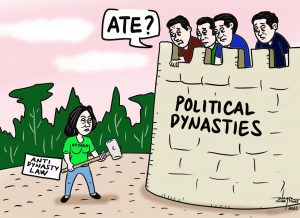There really are a number of marketing “geniuses” in our midst.
Some of these “geniuses” are working in businesses that are producing certain learning materials that are seen to help in the attainment of one major mandate of a particular government office.
The marketing “geniuses” without doubt, could have advanced the idea of selling their products to those seeking a major service of this public institution. And in collaboration with “benefit-hungy” officials in that office they are able to craft a marketing strategy that will compel every seeker of such major service of the office to buy the product.
Imagine, each product is sold at P500 a piece! And any service seeker who wants to beg off because he or she already has one such product courtesy of a brother or sister or a friend who had sought the same service from the government agency earlier? Sorry, they cannot escape from buying, or else…
But of course many oblige with the scheme which is made a requirement for the grant of the intension of the service seekers. The P500 cost of the product plus some minor expenses for the other requirements could still be much lesser than the expenses that may be incurred when the service applicant has to come to the city proper where the services are normally provided by the government entity.
Indeed there are a number of “innovative” ways of making money.
******************************
There, they are again.
We mean the members of the Davao City Council approving a huge property developer to convert a large chunk of the slope of Shrine Hills into a high end residential enclave seemingly unmindful of its negative consequences both in the near and far future.
Already, the developer of Elize Point, One Davao Township Corporation, posted on Facebook that it broke ground for its 4-hectare project last June 17, 2024.
The post elicited quick reaction from the environmentalist group Interfacing Development Intervention for sustainability (IDIS). It reminded the local authorities that the location of the development is well within the area covered by the Landslide Susceptibility Maps of the Mines and Geosciences Bureau (MGB) Region XI.
It may be recalled that the entire Shrine Hills area of 222 hectares was declared in 2013 as an Urban Ecological Enhancement Sub-Zone in the city’s Comprehensive Land Use Plan and Zoning Ordinance for 2011 up to 2022. The ordinance provides for “strict restrictions” for land development in areas categorized as such under the said local law.
If we remember right, it is within the same area or just in the vicinity thereof where a housing subdivision development was applied by the firm owned by former Senate President Manuel Villar. While the property appeared to have already been acquired and initial road constructions were undertaken, the development was eventually stopped. We assumed that the City Council then finally had the courage to reject the application from a company owned by one influential person. The Council’s eventual disapproval of the Villar development project was of course lauded profusely by the same environmental advocate group IDIS and the residents of Maa.
How come the present membership of the Davao City Council, some of whom were members of the same legislative body that rejected the Villar development project forget so easily of that landmark decision by the previous policy makers?
Are the members of the present Council so willing to risk the lives of the people of Maa and Matina in exchange of tax money the amount of which is likely to pale in comparison to the cost in lives and properties should there be major incidents of landslides or flood brought about by the intervention in the Shrine Hills contour with the development of this new residential subdivision?
If the councilors think that the development in that portion of the Shrine Hills slope will bring in more financial take to the city’s coffer are they ready with measures that can mitigate the impact of possible disastrous incidents and in addressing the needs of would-be victims?
Or would the honorable Council members rather adhere to the common excuse, “We will cross the bridge when we come to it?”



